Section contents:
Feature Image: Photograph of live-dead sampling of an oyster reef in South Carolina. Photograph courtesy of Jansen Smith.
Case Studies
Live-dead analyses can be a useful tool to inform conservation efforts and decisions. To effectively apply this tool, conservation paleobiologists research any available historical information (e.g., primary literature, maps, records), and consult local resource managers and/or other stakeholders knowledgeable about each study location to help identify potential cause(s) of a live-dead mismatch. This section highlights some case studies from the scientific literature to demonstrate how researchers conduct live-dead analyses to identify potential environmental stressors.
Case Study 1: Death Assemblages as a Recorder of Climate Change on the Mid-Atlantic Bight and Georges Bank (Powell et al., 2020)
Background:
Atlantic surfclams (Spisula solidissima) and ocean quahogs (Artica islandica) are two commonly fished clam species native to the Atlantic coast of the United States. Historically, surfclams occupied inshore waters, whereas quahogs were found offshore in cooler waters. However, recent studies have documented surfclams to be shifting to more offshore environments since the 1980s. Since the end of the Little Ice Age in the early 1800s, the waters off the northeast Atlantic Coast have been warming on average at a fairly rapid rate compared to other oceanic regions. Therefore, this shift could be due to temperature changes associated with climate change.
A previous study by Powell et al. (2017) used survey dredging records off the Georges Bank region to compare the presence of live and dead shells of both species to see how the populations might be shifting spatially. The study found that these once spatially distinct clam populations are beginning to overlap. If this pattern existed across a broader spatial scale, rather than being a pattern unique to the Georges Bank, it would be consistent with climate change as a likely stressor.
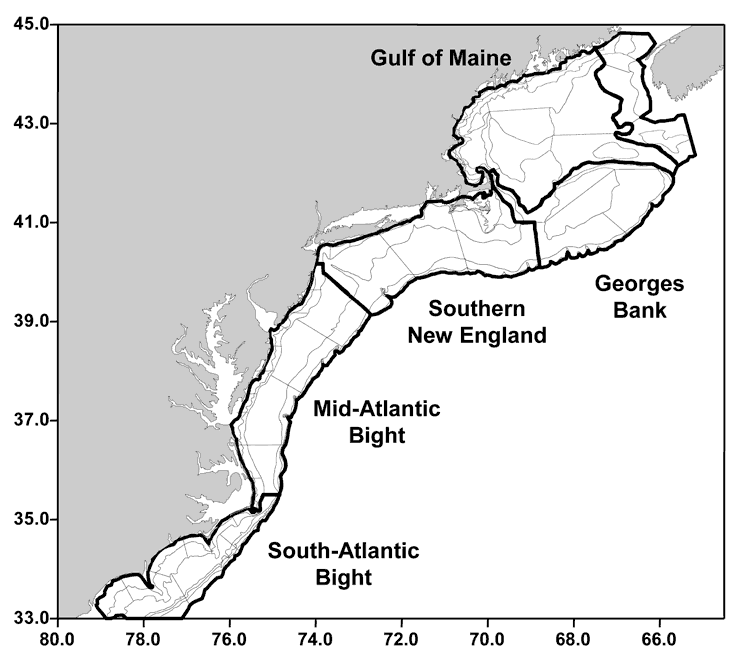
Map showing the study area from Georges Bank to the Mid-Atlantic Bight (the coast of Massachusetts to the Chesapeake Bay). Image by NOAA (2012; Wikimedia Commons; Creative Commons Attribution-Share Alike 4.0 International license).
Research Question:
Can the findings of Powell et al. (2017) from the Georges Bank be expanded over the broader spatial extent of the Mid-Atlantic Bight to confirm that the current live-dead distribution patterns for surfclams and quahogs are a response to climate change?
Environmental Stressor:
Changing bottom water temperature due to climate change.
Methods:
National Marine Fisheries Service - Northeast Fisheries Science Center survey dredging records spanning from the Georges Bank off the coast of Massachusetts to the Chesapeake Bay in Virginia were examined to assess the presence of live and dead surfclam and quahog shells. The surveys were conducted from 1978-2011 using a hydraulic dredge with tows typically five minutes in duration at 1.5 knots that efficiently captured live and dead shells >50mm. Due to changes in dredge size over time, differences in how data were recorded (abundance vs. number of bushels), and because dead shells were often only recorded by occurrence, only the presence-absence of live and dead shells was compared to avoid potential biases.
Analyses:
The spatial distribution patterns of the death assemblages were compared to the living community to determine if there was a mismatch. Four possible states were recorded for each dredge tow for both surfclams and quahogs: 1) no clams present, 2) only live clams present, 3) only dead clams present, and 4) both live and dead clams present. Nearby dredge tows were then compared to identify any spatial trends in the live and dead presence of both species to track where both the living and dead populations were primarily located.
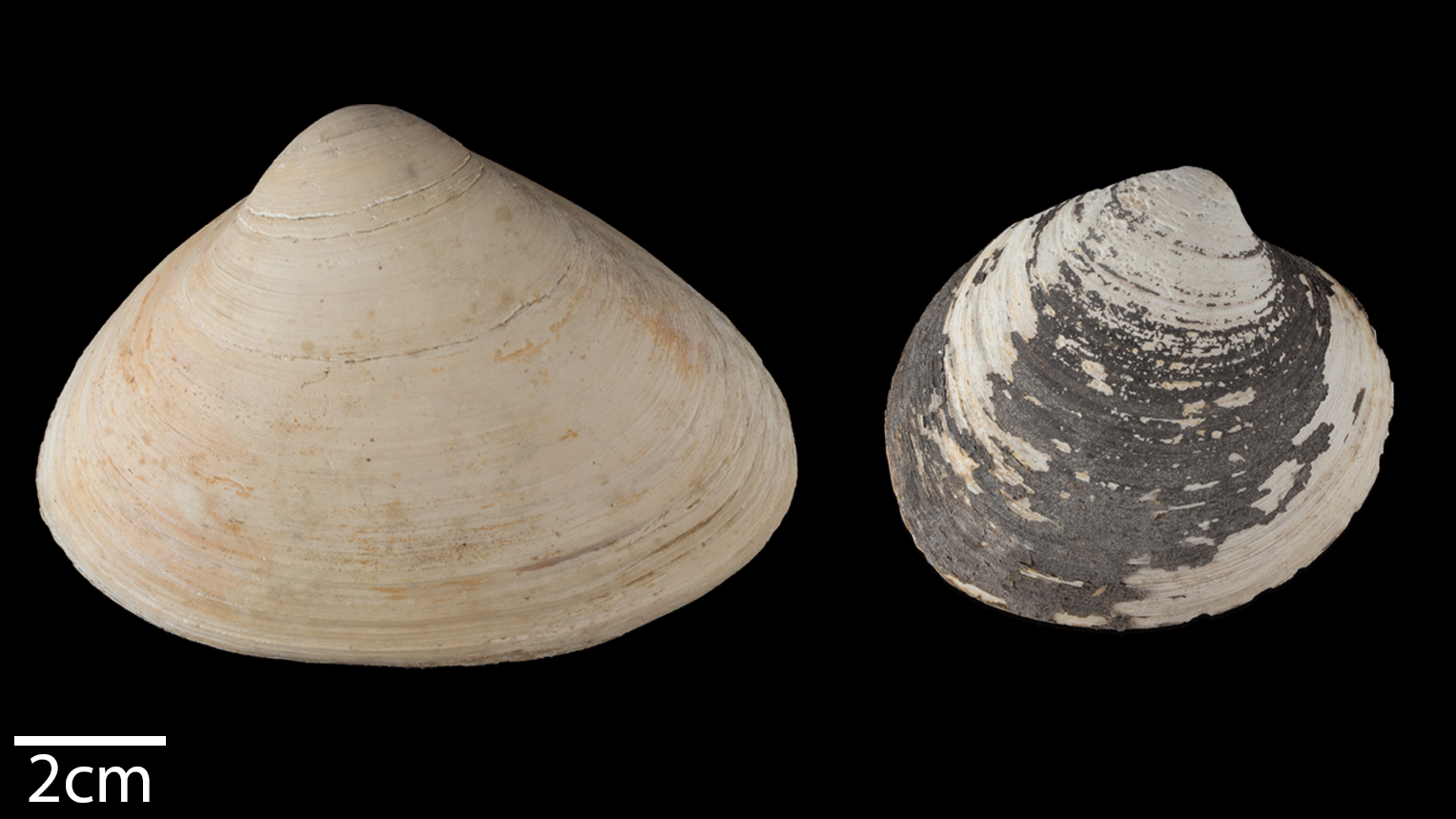
Left: A surfclam (Spisula solidissima: PRI 108739). Right: An ocean quahog (Arctica islandica: PRI 108738). Specimens are from the collections of the Paleontological Research Institution, Ithaca, New York. Photographs by Jaleigh Q. Goben.
Results and Discussion:
A significant mismatch in the location of living and dead shells was evident. Only ~20% of samples found both live surfclams and quahogs coexisting, whereas the remaining samples primarily had either live surfclams or live quahogs present. Live surfclam populations were found inshore of live quahog populations, with overlap in between. Dead surfclam shells were found in offshore areas where living populations currently do not exist, however, without dating the dead shells it is unknown when those populations were alive. To exist offshore, the waters would need to have been warmer than today to support live surfclams. The quahog populations seem largely unchanged and primarily in more offshore regions, although dead shells did exist in nearshore regions as well. Similarly, it is difficult to know when those populations were alive in the past without dating the shells. For quahogs to exist inshore of their current range, water temperatures would need to have been cooler than today.
What can be concluded from these patterns is that live surfclams are moving into more offshore habitat, inhabiting areas currently occupied by quahogs. In the past, both surfclams and quahogs lived across the shelf (both inshore and offshore), likely tracking suitable habitat due to changing temperatures. Because these patterns are evident across a broad geographic area, they can be largely attributed to climate change instead of a more localized stressor. The mismatch between the living and death assemblages provides an understanding of past migration that can be used to develop scenarios of where these clam species might migrate in the future as bottom waters continue to warm with climate change.
Case Study 2: Wastewater Discharge in the Mediterranean Sea (Leshno et al., 2015)
Background:
The Shafdan project in Israel treats wastewater for two-million people within the Tel-Aviv Metropolitan area and since 1987 has discharged excess sludge into the Mediterranean Sea.

District map of the city of Tel Aviv along the Mediterranean Sea. The sewage pipeline location of interest in Leshno et al. (2015) is south of Jaffa. Image by Pavel Belsky (Wikimedia Commons; Creative Commons Attribution-Share Alike 4.0 International license).
Research Question:
Is localized pollution from the wastewater discharge pipe off the Mediterranean coast south of Tel-Aviv, Israel, affecting the nearby Mediterranean molluscan communities?
Environmental Stressor:
Pollution from wastewater influx.
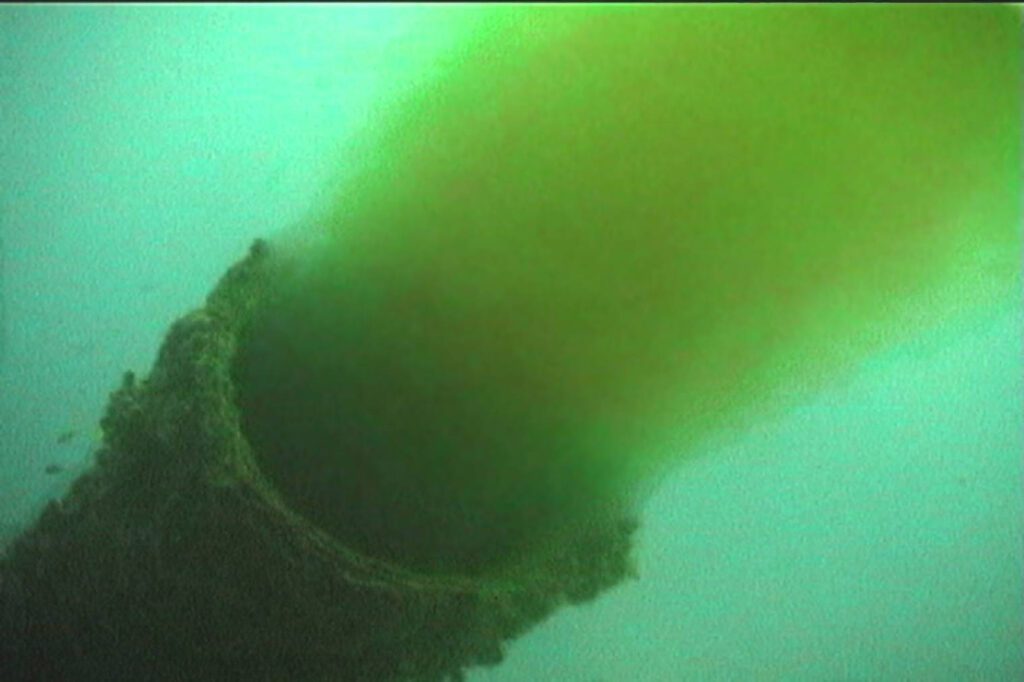
Photograph of a sewage discharge pipeline into the ocean. Image by user ‘eutrophication&hypoxia’ (Flickr; Creative Commons BY 2.0).
Methods:
In 2012, living and death assemblages at three locations were sampled four times (winter, spring, summer, and fall), including one site near the discharge pipeline (polluted) and two sites 5 and 7 kilometers north of the discharge pipeline (non-polluted). The death assemblage was sampled with a 0.625m2 GOMEX box-corer or 0.1m2 Van Veen grab, and the presence of live mollusks was recorded. The living assemblage was sampled by dragging a dredge (45 x 60 x 8cm3) over a 30m seafloor transect at each site. Sampling volume was used to account for differences between sampling methods (See Box 1). Samples were washed over 2mm sieves and dried prior to sorting. Species were identified and counted.
Analyses:
To compare living and death assemblage samples taken at the same site, raw species abundance was used to calculate species richness, diversity, and evenness (see Box 2) across all living and death assemblage samples. Species taxonomy, similarity, and relative abundances were compared between living and death assemblages across sites (polluted and non-polluted; see Box 2).
Results and Discussion:
No differences, or meaningful mismatches, in species composition or relative abundance, were found for living and death assemblages across site locations (polluted vs. non-polluted) or seasons. About 76% of living species were also found in the death assemblage, indicating a high degree of matching. The most abundant species were also similar in both the living and death assemblages, dominated by environmentally tolerant species. Consistent species composition may indicate local species are tolerant to environmental stresses or that they can quickly repopulate areas exposed to disturbance.
A significant mismatch occurred when living and death assemblages were compared at the same site, especially in the ecology of species’ feeding modes. The death assemblages were more diverse and included more rare species, which might be an effect of high time-averaging although no sample dating methods were conducted to confirm. However, the death assemblages also included more filter feeders (filtering food particles from the water) whereas the living assemblages included more deposit feeders, indicating a shift in feeding mode over time. Deposit feeders (sifting sediment for food particles) thrive in stressed environments where a higher abundance can indicate the presence of anthropogenic eutrophication.
Other environmental variables such as water depth, temperature, and salinity did not differ across sites, but storms were more frequent in 2012 compared to prior years. A higher storm frequency could have prevented the accumulation of a thick sludge layer and associated hypoxia (low-oxygen) close to the discharge pipeline, lessening the effects of localized pollution. The loss of environmentally sensitive species and the dominance of more tolerant species highlight how the effects of pollution can be tracked over time using the live-dead mismatch approach.
Case Study 3: Sea-Bottom Trawling and Pollution in the Gulf of Thailand (Negri et al., 2015)
Background:
The Phetchaburi Province of the Gulf of Thailand is a part of the Indo-Burma area, one of 25 recognized world biodiversity hotspots, and has been under pressure from human activities that have likely impacted the benthic communities. Anthropogenic pressures include intertidal shellfish harvesting, agricultural runoff, mangrove deforestation, and extensive sea-bottom trawling.
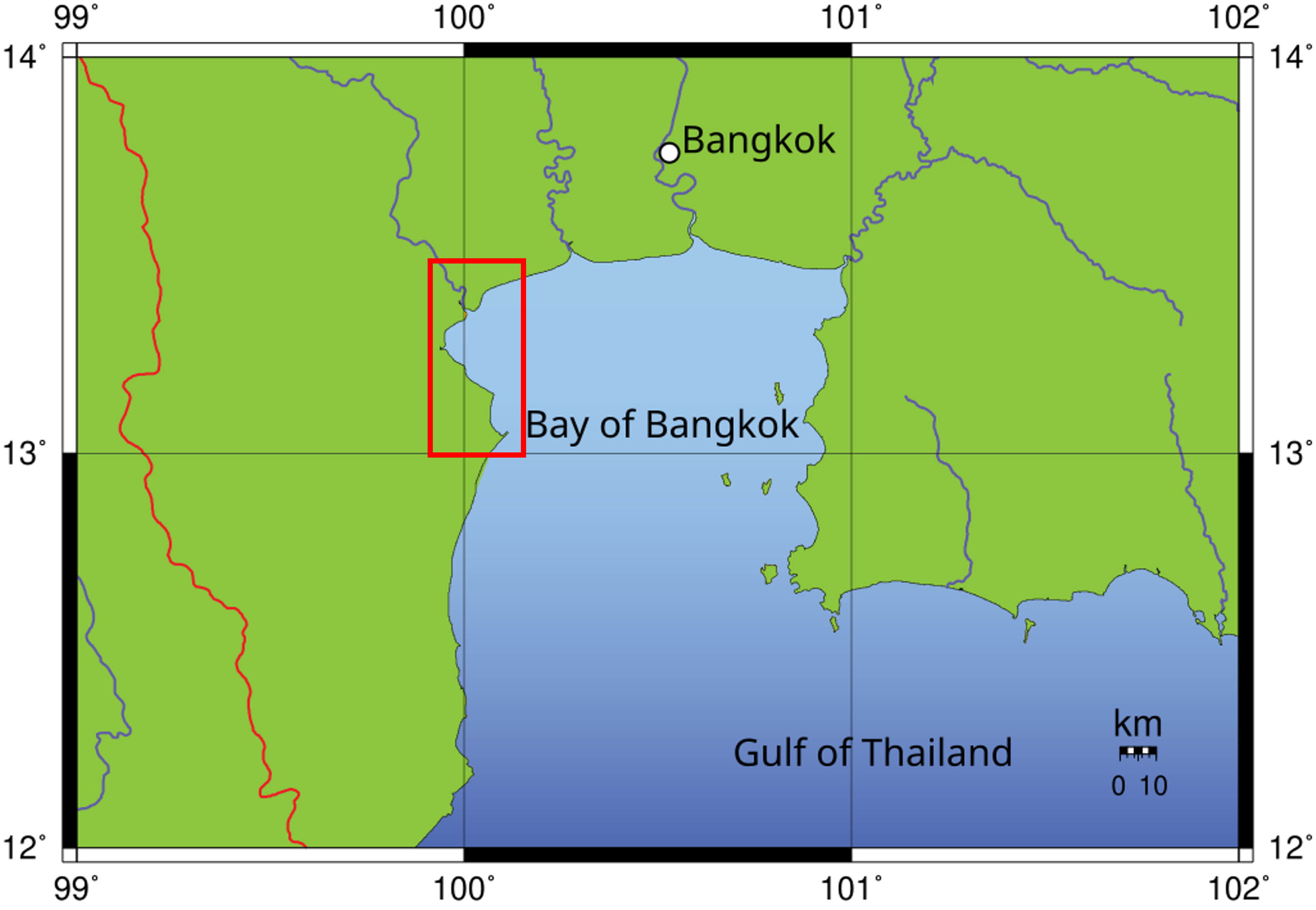
Modified map of the Bay of Bangkok, Gulf of Thailand, with a red rectangle outlining the study area. Original image by Feydey (Wikimedia Commons; Public domain).
Research Question:
How have multiple anthropogenic stressors along the Phetchaburi coast, Thailand, affected the marine benthic biodiversity?
Environmental Stressors:
Sea-bottom trawling, pollution, and tidal flat harvesting of edible mollusks.
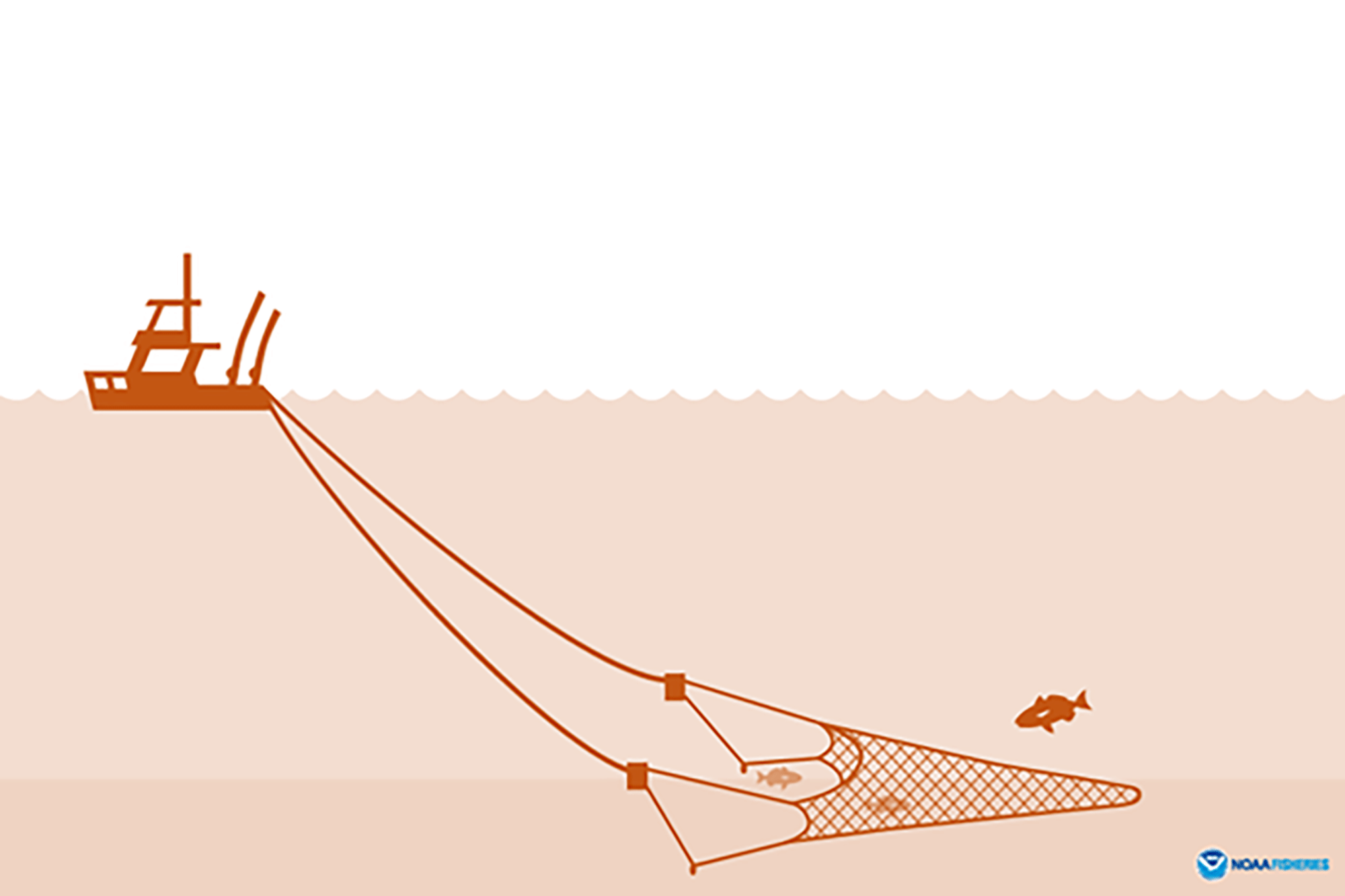
Sea bottom trawling. Graphic by National Oceanic and Atmospheric Administration (NOAA) Fisheries (public domain)
Methods:
From 1996 to 2003, 97 mollusk samples were collected along the shallow intertidal belt of the Phetchaburi coast. A 0.04m2 Van Veen grab sampler was used to collect 71 samples, a towed dredge for 23 samples, two samples were collected by hand, and one sample was collected via manual core (abundances were standardized by volume; see Box 1). All samples were washed and sieved using 2mm and 0.5mm mesh stacked sieves. Sediment and water samples were also collected alongside the benthic samples to measure grain size, temperature, salinity, dissolved oxygen, and pH. Lastly, shell size was recorded for several commonly harvested bivalve species in the area to see if size changed over time due to harvesting pressures.
Analyses:
Living (66 samples) and death assemblages (89 samples) were analyzed separately across sites to identify distinct groups of species (i.e., communities), by comparing the presence and abundance of species across sampling sites. The identified groups were then compared to environmental parameters such as water depth and sediment type. Other calculated metrics included evenness, diversity, and species richness (See Box 2).
Results and Discussion:
Groups of molluscan species differed wildly from the death and living assemblages indicating a mismatch. The death assemblage data consisted of seven highly diverse and distinct groups that corresponded with differences in environmental conditions (e.g., salinity and distance from mangrove forests). In contrast, the living assemblage data only indicated two sparse and low-diversity groups that broadly corresponded with water depth.
Sea-bottom trawling was suggested to be the most likely stressor contributing to the decline in biodiversity, as evidenced by the reduction of mean shell sizes in several bivalve species. For example, the undulate venus clam (Paratapes undulatus), a popular food in the area, saw a reduction in mean size from 22.5mm in the death assemblages to 4.5mm in the living assemblages. This size change indicates the undulate venus clam population in the study area has been getting smaller over time. Notably, in areas not affected by trawling, the mean shell sizes of living assemblage species were comparable to their death assemblage counterparts, indicating trawling was most likely the driving stressor impacting the molluscan communities. Lastly, an additional stressor of organic pollution from aquacultural practices may have also impacted diversity, as evidenced by the increase in relative abundance and dominance of deposit feeders, which tend to thrive in eutrophic (nutrient-rich) conditions, from the death to the living assemblage.
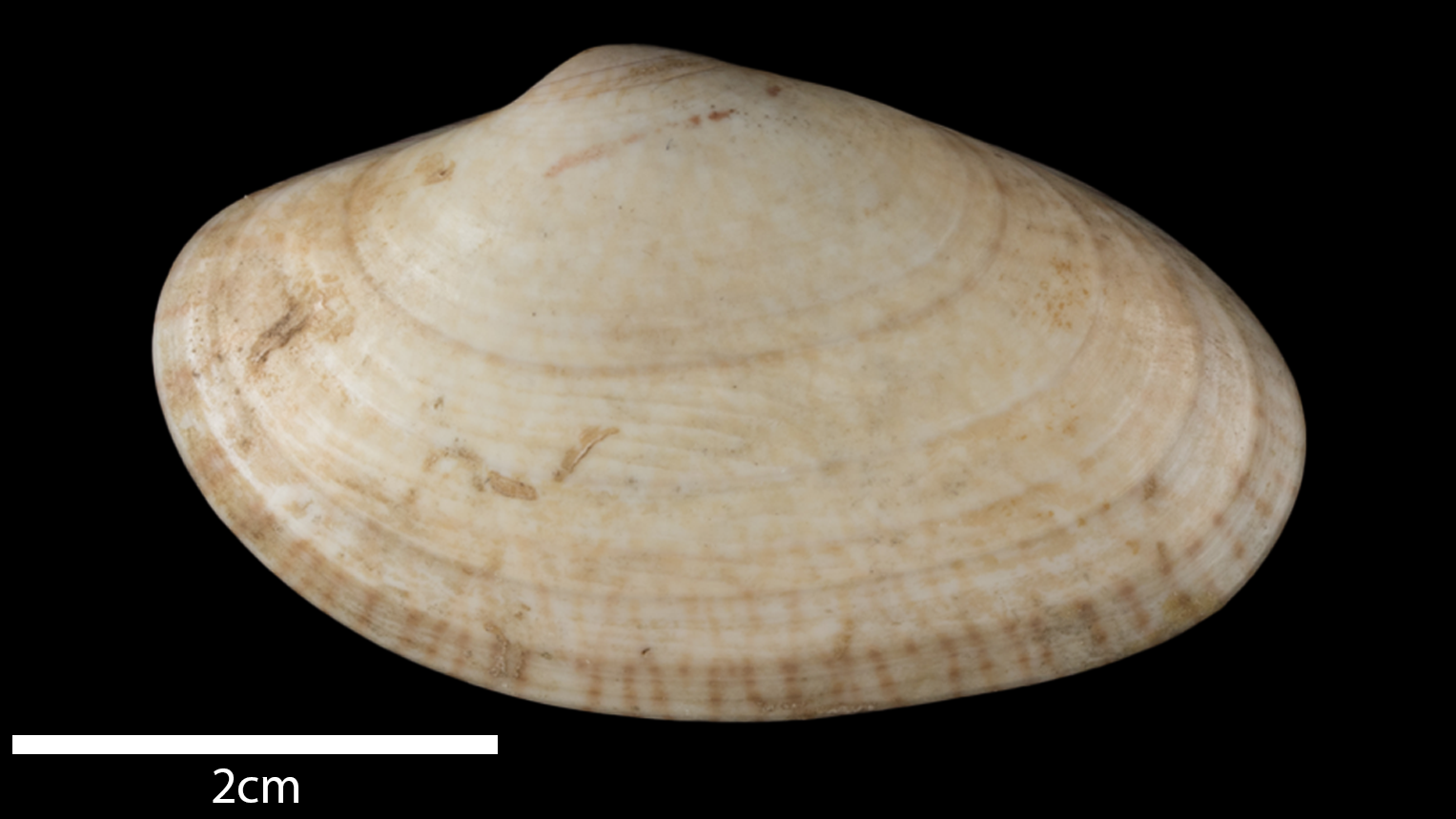
A photograph of an undulate venus clam (Paratapes undulatus; PRI 89347). Specimen is from the collections of the Paleontological Research Institution, Ithaca, New York. Photograph by Jaleigh Q. Goben.
Case Study Limitations
None of the above case studies radiocarbon dated shells to determine robust estimates for the age of the death assemblages, which is important to help identify the timing of potential stressors. Radiocarbon dating is a common limitation for many live-dead analyses due primarily to cost. If it were more feasible to radiocarbon date shells in large quantities, it could potentially strengthen the findings of these studies if the death assemblages were confirmed to be an appropriate age. Conversely, dating the shells could show that the death assemblages were either too old or too young.
Looking to the Future
Live-dead mismatch is one tool from a conservation paleobiologist’s toolbox to help extend ecological baselines further into the past and identify potential environmental stressors that could be causing local change. Live-dead studies can help provide information pertaining to changes over time, which can be useful in the absence of long-term records to inform management decisions. Here, we provided some examples for shallow, marine, soft-sediment environments using mollusks; however, live-dead mismatch can be applied as a conservation tool in other environments (e.g., freshwater) with other taxa (e.g., ostracods, diatoms, etc.). Additional sampling methods, like coring, can help provide even longer records of change in a given location to establish baselines from deeper in the past (e.g., decades, centuries, millennia).
Video: Live-dead Analyses
Watch this video to learn more about live-dead analyses:
What are live-dead analyses in conservation paleobiology? by the Paleontological Research Institution (YouTube).
References & Further Reading:
Leshno, Y., Y. Edelman-Furstenberg, H. Mienis,, and C. Benjamini. 2015. Molluscan live and dead assemblages in an anthropogenically stressed shallow-shelf: Levantine margin of Israel. Palaeogeography, Palaeoclimatology, Palaeoecology, 433: 49-59.
Negri, M. P., R. Sanfilippo, D. Basso, and A. Rosso. 2015. Comparison of live and dead molluscan assemblages suggests recent human-driven decline in benthic diversity in Phetchaburi (NW Gulf of Thailand). Continental Shelf Research, 111: 9-30.
Powell, E.N., Kuykendall, K.M., and P. Moreno. 2017. The death assemblage as a marker for habitat and an indicator of climate change: Georges Bank, surfclams and ocean quahogs. Continental Shelf Research, 142: 14-31.
Powell, E. N., A. M. Ewing, and K. M. Kuykendall. 2020. Ocean quahogs (Arctica islandica) and Atlantic surfclams (Spisula solidissima) on the Mid-Atlantic Bight continental shelf and Georges Bank: the death assemblage as a recorder of climate change and the reorganization of the continental shelf benthos. Palaeogeography, Palaeoclimatology, Palaeoecology, 537: 109205.



